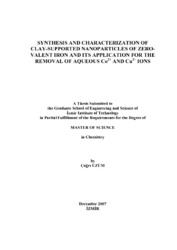Please use this identifier to cite or link to this item:
https://hdl.handle.net/11147/3931| Title: | Synthesis and characterization of clay-supported naoparticles of zero-valent iron and its application for the removal of aqueous Co2+ and Cu2+ ions | Authors: | Üzüm, Çağrı | Advisors: | Shahwan, Talal | Publisher: | Izmir Institute of Technology | Abstract: | In recent years Permeable Reactive Barriers (PRBs) are being developed and used in the removal of organic and inorganic pollutants from surface water and groundwater. Zero-valent iron is viewed as an ideal reactive material for PRBs by means of its high sorption/reduction capacity towards various toxic ions. Zero-valent iron synthesized in nanoscale has a greater affinity to reduce/adsorb various toxic aqueous ions by virtue of its large surface area.In this work, nanoscaled (10-100nm) zero-valent iron (nZVI) was synthesized in ethanol by borohydride reduction method in atmospheric conditions. It was observed that iron nanoparticles are mainly in zero-valent oxidation state and that they remain without significant oxidation for weeks. To enhance its effect and usability, nZVI was supported by kaolinite and montmorillonite during synthesis. Characterization of those clay-supported nZVI was performed using XRD, SEM, TEM, EELS, XPS, Zeta Meter, BET-N2. Iron nanoparticles consist of a zero-valent core and a surrounding oxide shell with approximate thickness of 3-5 nm. The application of clays as support materials have led to a partial decrease in the aggregation of iron nanoparticles known to normally form chain-like structure. The diameter of unsupported iron nanoparticles was predominently within the range 20-80 nm, while clay-supported iron nanoparticles existing as dispersed nano spheres had particle diameters within 10-50 nm.The synthesized materials were applied as adsorbents for Co2+ and Cu2+ ions. According to the results , unsupported and clay-supported nZVI has a great capacity to immobilize Co2+ and Cu2+ ions with very fast kinetics. While Co2+ seems to be fixed via the oxohydroxyl groups on the surface of iron nanoparticles, Cu2+ was fixed by a redox mechanism that lead to formation of Cu2O and Cu0. The performed studies indicate that kaolinite- and montmorillonite-supported zero-valent iron nanoparticles are promising reactive materials for environmental applications. | Description: | Thesis (Master)--İzmir Institute of Technology, Chemistry, İzmir, 2008 Includes bibliographical references (leaves: 68-73) Text in English; Abstract: Turkish and English xii, 73 leaves |
URI: | http://hdl.handle.net/11147/3931 |
| Appears in Collections: | Master Degree / Yüksek Lisans Tezleri |
Files in This Item:
| File | Description | Size | Format | |
|---|---|---|---|---|
| T000690.pdf | MasterThesis | 3.89 MB | Adobe PDF |  View/Open |
CORE Recommender
Page view(s)
134
checked on Jul 22, 2024
Download(s)
92
checked on Jul 22, 2024
Google ScholarTM
Check
Items in GCRIS Repository are protected by copyright, with all rights reserved, unless otherwise indicated.